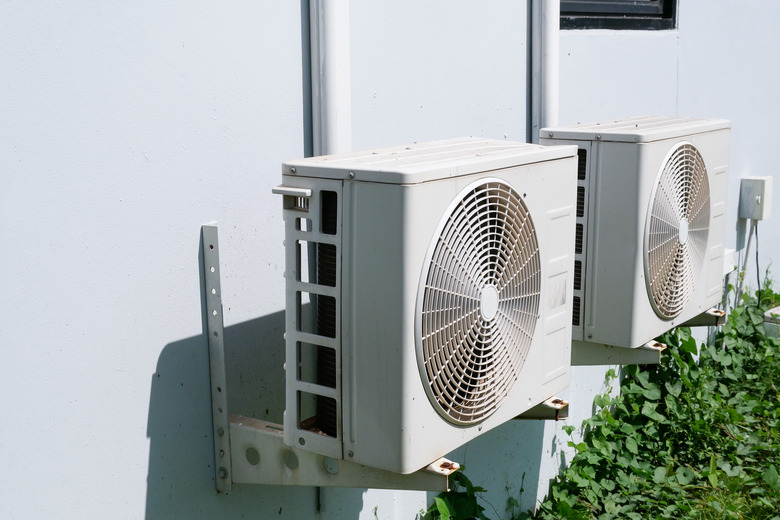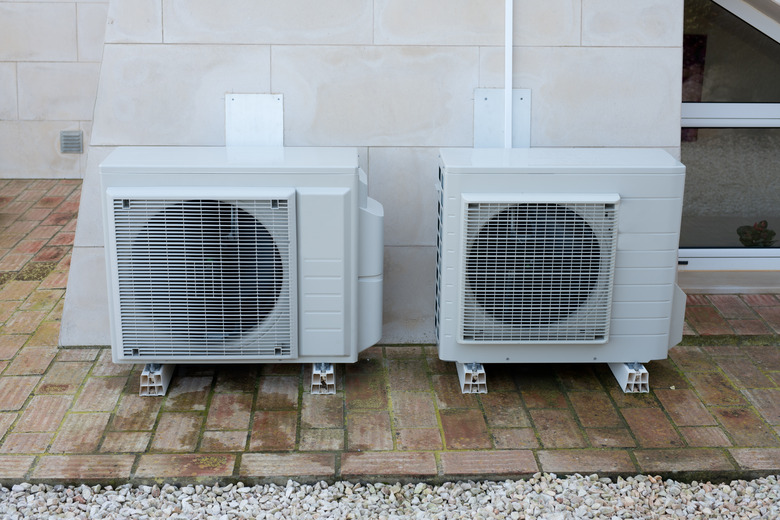Troubleshooting An Air-Source Heat Pump
We may receive a commission on purchases made from links.
A heat pump is basically an air conditioner that can run in reverse, so heat pump troubleshooting is similar to troubleshooting a central air conditioner. But because of the system's complexity, you can't fix very many things yourself. A heat pump has a refrigeration system like that in an air conditioner or refrigerator, and because a refrigerant leak is a potential environmental issue, only licensed HVAC technicians are allowed to service these systems. Besides that, heat pumps have complex reversing mechanisms to switch between heating and cooling, and servicing the components and circuitry of these mechanisms is generally beyond the scope of the average homeowner.
Even though there are many problems you can't fix yourself, there are some that you can. Sometimes, all you need to do to fix common heat pump problems is to reset a tripped breaker or change a setting on the thermostat. Like that of an air conditioner, a heat pump's performance can be adversely affected by clogged air filters, dirt on the coils and other maintenance issues, and not only can homeowners address these but they should because a service call to change a filter or clean dirty coils is a waste of money if nothing else is wrong.
Know Your Heat Pump System
Know Your Heat Pump System
A central heat pump system consists of an outdoor unit and an air handler inside the building, and they are connected by tubing that runs through the wall and is formed into two sets of coils: one indoors and one outdoors. The tubing is filled with refrigerant that is circulated by a compressor in the outdoor unit. When the heat pump is running as a heating system, the indoor coils get hot, and a blower in the air handler circulates the hot air through the building's ductwork. When cooling is needed, a reversing valve changes the direction of the refrigerant flow, and the indoor coils get cold. The temperatures of the indoor and outdoor coils move in opposite directions — the outdoor coils get cold when the indoor coils are hot and vice versa.
Besides the reversing valve, the other moving parts of the system are the compressor, the compressor fan and the blower. When any of these components fails and you can't trace the problem to a breaker or fuse, you need professional help. You also need an HVAC pro if you suspect a refrigerant leak.
Problem: The Heat Pump Won't Switch On
Problem: The Heat Pump Won't Switch On
When the entire system won't turn on, the first thing for which to look is a tripped breaker in the home's main service panel, or breaker box. If all the breakers are good, turn your attention to the thermostat. Is it switched to the correct function? If it's set to the cooling mode, switch it to the heating mode, and make sure the fan is set to auto.
If that doesn't work, turn off the breaker controlling the heat pump, remove the thermostat cover and check the wires to make sure they're tight. Pay special attention to the main power wire, which is the one connected to the R terminal, and the wire connected to the O or B terminal, which are the ones that control the reversing valve. If you don't see an O or B terminal, the thermostat is designed to control a heating system (such as a furnace) together with a cooling system (such as a central AC unit) but not a heat pump. This means you need to replace the thermostat with an appropriate model. This kind of mismatch isn't common, but it can happen.
Problem: There Isn't Enough Heat
Problem: There Isn't Enough Heat
When you're getting cold air and you should be getting hot air, the problem could again be that the thermostat is set to the wrong function. Make sure it's set for heat and that the fan is switched to auto.
Assuming the thermostat is working as it should, the cause of a heat pump blowing air that isn't as hot as it should be can usually be traced to the outside unit and one or more of these conditions:
- Poor air circulation: The outdoor unit's housing may be covered with debris that is preventing air circulation around the coils, or the air filter may be clogged. Clean debris from the housing and replace the filter.
- Coils have iced over: A certain amount of icing is normal, and a heat pump periodically goes into defrost mode to control it, but if airflow is blocked by debris on the housing or a dirty air filter, there may be enough buildup to prevent the coils from absorbing heat from the outdoor air. A leak in the housing can also allow water to enter and freeze on the coils, and the defrost cycle may not be able to get rid of it all. Deicing the coils is a job best done by a pro, as you can damage the coils if you try to do it yourself.
- Dirty coils: The outdoor coils may simply be dirty. You can clean them yourself using a duster and compressed air.
- Refrigerant leak: If there isn't enough refrigerant in the coils, they can ice over, but even if they don't, the heat pump won't perform as well as it should. Suspect a refrigerant leak when you can't find any other causes for poor performance and call an HVAC tech for servicing and a refrigerant charge.
Problem: The Fan Won't Come On
Problem: The Fan Won't Come On
A heat pump has two fans, one in the air handler and the other in the compressor housing, and both have to be working for the heat pump system to produce hot or cool air and to circulate it throughout the house. Assuming a circuit breaker hasn't tripped, it often takes a series of electrical tests to troubleshoot a fan motor that won't start. The problem could be a blown fuse, a burned-out connection or a bad relay, and it usually takes an HVAC specialist with the proper equipment to pinpoint the issue.
If you hear strange grinding, humming or squealing noises from either the fan motor or from the compressor, shut down the system and call for service. These noises often signify loose bearings and other components that could cause failure, and if a part fails, it could affect other parts, which would also have to be replaced. Play it safe and shut down the system before that happens.
Problem: Continuous Operation in Moderate Weather
Problem: Continuous Operation in Moderate Weather
If you're experiencing very hot or very cold weather, it's normal for the heat pump to run continuously to maintain a stable room temperature. If the weather is moderate, however, the unit should cycle on and off, and continuous operation indicates poor efficiency. This is one of those heat pump problems you can often fix yourself by just changing the air filter or checking the thermostat to make sure it's in the correct mode. However, it could also indicate a more serious problem that calls for a heat pump repair specialist, such as a refrigerant leak or a bad reversing valve.
Be Sure to Perform Regular Maintenance
Be Sure to Perform Regular Maintenance
Before your heat pump turns into an expensive problem, give it the TLC you would give any HVAC system component. Clean or replace the air filter in the outdoor unit regularly and check the unit for obstacles impeding airflow. Schedule a yearly tune-up so a technician can test components, look for failing connections and generally head off minor problems before they turn into major ones.

